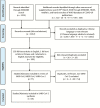SARS-CoV-2 (COVID-19): What Do We Know About Children? A Systematic Review
- PMID: 32392337
- PMCID: PMC7239259
- DOI: 10.1093/cid/ciaa556
SARS-CoV-2 (COVID-19): What Do We Know About Children? A Systematic Review
Abstract
Background: Few pediatric cases of coronavirus disease 2019 (COVID-19) have been reported and we know little about the epidemiology in children, although more is known about other coronaviruses. We aimed to understand the infection rate, clinical presentation, clinical outcomes, and transmission dynamics for severe acute respiratory syndrome coronavirus 2 (SARS-CoV-2), in order to inform clinical and public health measures.
Methods: We undertook a rapid systematic review and narrative synthesis of all literature relating to SARS-CoV-2 in pediatric populations. The search terms also included SARS-CoV and MERS-CoV. We searched 3 databases and the COVID-19 resource centers of 11 major journals and publishers. English abstracts of Chinese-language papers were included. Data were extracted and narrative syntheses conducted.
Results: Twenty-four studies relating to COVID-19 were included in the review. Children appear to be less affected by COVID-19 than adults by observed rate of cases in large epidemiological studies. Limited data on attack rate indicate that children are just as susceptible to infection. Data on clinical outcomes are scarce but include several reports of asymptomatic infection and a milder course of disease in young children, although radiological abnormalities are noted. Severe cases are not reported in detail and there are few data relating to transmission.
Conclusions: Children appear to have a low observed case rate of COVID-19 but may have rates similar to adults of infection with SARS-CoV-2. This discrepancy may be because children are asymptomatic or too mildly infected to draw medical attention and be tested and counted in observed cases of COVID-19.
Keywords: COVID-19; SARS-CoV-2; children; coronavirus; infection.
© The Author(s) 2020. Published by Oxford University Press for the Infectious Diseases Society of America.
Figures

Comment in
-
It's True Even in a Pandemic: Children Are Not Merely Little Adults.Clin Infect Dis. 2020 Dec 3;71(9):2480-2481. doi: 10.1093/cid/ciaa680. Clin Infect Dis. 2020. PMID: 32472937 Free PMC article. No abstract available.
Similar articles
-
Human and novel coronavirus infections in children: a review.Paediatr Int Child Health. 2021 Feb;41(1):36-55. doi: 10.1080/20469047.2020.1781356. Epub 2020 Jun 25. Paediatr Int Child Health. 2021. PMID: 32584199 Review.
-
COVID-19 infection in children with blood cancer: A systematic review.Ann Hematol. 2025 Feb;104(2):1203-1230. doi: 10.1007/s00277-024-06057-4. Epub 2024 Nov 5. Ann Hematol. 2025. PMID: 39496811 Free PMC article.
-
Children and Adolescents With SARS-CoV-2 Infection: Epidemiology, Clinical Course and Viral Loads.Pediatr Infect Dis J. 2020 Dec;39(12):e388-e392. doi: 10.1097/INF.0000000000002899. Pediatr Infect Dis J. 2020. PMID: 33031141
-
Folic acid supplementation and malaria susceptibility and severity among people taking antifolate antimalarial drugs in endemic areas.Cochrane Database Syst Rev. 2022 Feb 1;2(2022):CD014217. doi: 10.1002/14651858.CD014217. Cochrane Database Syst Rev. 2022. PMID: 36321557 Free PMC article.
-
Transmission dynamics of SARS-CoV-2 within families with children in Greece: A study of 23 clusters.J Med Virol. 2021 Mar;93(3):1414-1420. doi: 10.1002/jmv.26394. Epub 2020 Aug 26. J Med Virol. 2021. PMID: 32767703 Free PMC article.
Cited by
-
High Prevalence of Undocumented SARS-CoV-2 Infections in the Pediatric Population of the Tyrolean District of Schwaz.Viruses. 2022 Oct 19;14(10):2294. doi: 10.3390/v14102294. Viruses. 2022. PMID: 36298849 Free PMC article.
-
Smell and Taste in Children with Covid-19.Allergy Rhinol (Providence). 2022 Dec 15;13:21526575221144950. doi: 10.1177/21526575221144950. eCollection 2022 Jan-Dec. Allergy Rhinol (Providence). 2022. PMID: 36571076 Free PMC article.
-
ICU Admission, Invasive Mechanical Ventilation, and Mortality among Children and Adolescents Hospitalized for COVID-19 in a Private Healthcare System.Int J Pediatr. 2023 Feb 23;2023:1698407. doi: 10.1155/2023/1698407. eCollection 2023. Int J Pediatr. 2023. PMID: 36873820 Free PMC article.
-
Differentiating abdominal pain due to COVID-19 associated multisystem inflammatory syndrome from children with acute appendicitis: a score system.Pediatr Surg Int. 2023 Mar 10;39(1):151. doi: 10.1007/s00383-023-05432-y. Pediatr Surg Int. 2023. PMID: 36897476 Free PMC article.
-
Behavioral Intention and Its Predictors toward COVID-19 Booster Vaccination among Chinese Parents: Applying Two Behavioral Theories.Int J Environ Res Public Health. 2022 Jun 20;19(12):7520. doi: 10.3390/ijerph19127520. Int J Environ Res Public Health. 2022. PMID: 35742770 Free PMC article.
References
-
- World Health Organization. Coronavirus disease 2019 (COVID-19) situation report–51. World Health Organization, 11 March 2020. Available at: https://www.who.int/docs/default-source/coronaviruse/situation-reports/2.... Accessed 12 March 2020.
-
- Ison MG, Lee N. Noninfluenza respiratory viruses. In: Cohen J, Powderly W, Opal S, eds. Infectious diseases. 4th ed. Vol. 22017 London: Elsevier, 2017:1472–82.
-
- World Health Organization, Department of Communicable Disease Surveillance and Response. Consensus document on the epidemiology of severe acute respiratory syndrome (SARS) World Health Organization, 2003. Available at: https://www.who.int/csr/sars/en/WHOconsensus.pdf. Accessed 9 March 2020.
-
- World Health Organization. Middle East respiratory syndrome coronavirus (MERS-CoV), MERS Monthly Summary, November 2019 World Health Organization, 2019. Available at: https://www.who.int/emergencies/mers-cov/en/. Accessed 9 March 2020.
Publication types
MeSH terms
LinkOut - more resources
Full Text Sources
Medical
Miscellaneous

